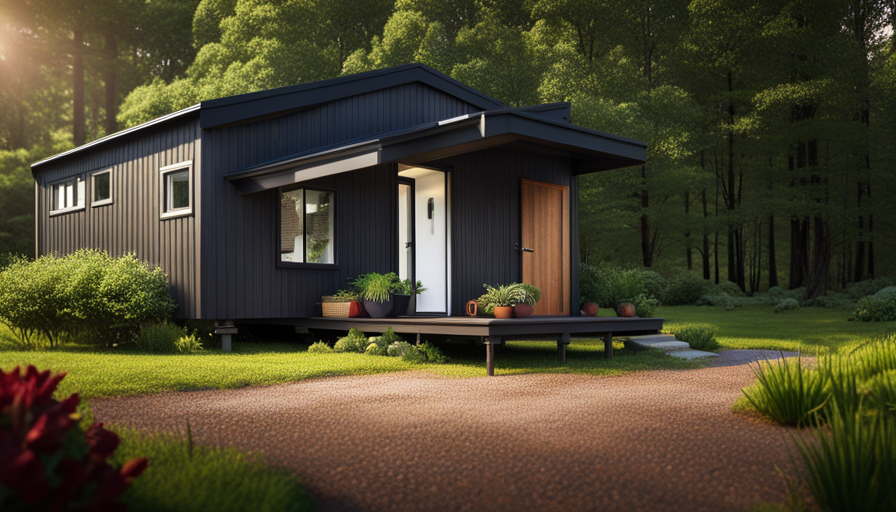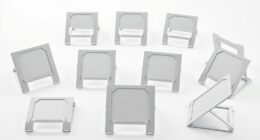Have you ever come home only to be greeted by a group of tiny flies buzzing around you? It’s a frustrating and irritating scenario that many of us have encountered.
These tiny flies, commonly known as fruit flies or gnats, seem to appear out of nowhere and can quickly become a nuisance. But fear not, because I’m here to provide you with some effective solutions to get rid of these pesky creatures once and for all.
Imagine walking into your kitchen, only to find an army of tiny flies congregating around your fruit bowl. It’s like a scene from a horror movie, with these tiny pests multiplying rapidly and invading your living space. But don’t worry, I’ve got you covered.
In this article, I will guide you through the steps to identify the type of fly you’re dealing with, locate the breeding source, and provide you with practical tips to clean and declutter your home.
We’ll explore the use of fly traps, natural remedies, and insecticides to combat these tiny flies. Plus, we’ll discuss the importance of maintaining cleanliness in your kitchen and bathroom to prevent future infestations.
So, buckle up and get ready to reclaim your house from these pesky invaders. Let’s dive into the world of tiny flies and discover how to eliminate them from your home once and for all.
Key Takeaways
- Identifying the type of fly is crucial for effective control measures.
- Regularly cleaning and decluttering the house, especially in clutter-prone areas, can help prevent fly infestations.
- Using homemade fly traps or natural remedies like essential oils can reduce the fly population.
- Proper sealing of cracks and openings, along with the use of insecticides or fly sprays, can help combat flies and prevent them from entering the house.
Identify the Type of Fly
To identify the type of fly infesting your house, you’ll need to closely examine their physical characteristics and behavior patterns. Start by looking for common fly species in your area.
Some common types of flies that can infest homes include fruit flies, drain flies, and fungus gnats. Fruit flies are small, about 1/8 inch long, and have a tan or brownish body with red eyes. They are often found near ripe fruits and vegetables.
Drain flies, also known as moth flies, are small, dark gray or black flies with hairy bodies. They are commonly found near drains, hence their name.
Fungus gnats are tiny, black flies that are attracted to damp soil and decaying organic matter. They are commonly found in houseplants.
To help you identify the species, you can refer to a fly identification guide, which will provide detailed descriptions and images of different fly species.
Once you have identified the type of fly, you can then proceed to locate the breeding source, which is crucial for effective fly control.
Locate the Breeding Source
One possible breeding source for those annoying little pests could be a forgotten bowl of fruit sitting on the kitchen counter, acting like a tiny fly magnet. Flies are attracted to decaying organic matter, such as fruits, vegetables, and even moist pet food. To prevent future infestations and understand fly behavior, it’s crucial to locate and eliminate these breeding sources.
Here are five key points to consider:
- Clean your kitchen thoroughly, paying attention to any spills or food remnants that might attract flies.
- Regularly empty and clean your trash cans, as they can provide a breeding ground for flies.
- Keep your drains clean and unclogged, as flies often lay their eggs in the organic matter that accumulates in drains.
- Store fruits and vegetables in the refrigerator or in sealed containers to prevent them from overripe and attracting flies.
- Check for any moist or decaying areas in your home, such as leaky pipes or damp corners, as these can be ideal breeding grounds for flies.
Understanding these breeding sources and taking necessary preventive measures can help you get rid of tiny flies in your house. By addressing these issues, you can create an environment that’s less inviting to flies and reduce the risk of future infestations.
Now, let’s move on to the next section on how to clean and declutter your home to further eliminate these pesky pests.
Clean and Declutter Your Home
Make sure you clean and declutter your home to create an environment that’s less inviting to those pesky little pests. Decluttering benefits your home in many ways, and one of them is reducing the chances of having tiny flies buzzing around.
These flies are attracted to organic matter, such as food scraps, garbage, and even damp areas. By removing clutter and organizing your belongings, you eliminate potential breeding grounds for these flies.
Start by going through your kitchen and disposing of any spoiled or overripe fruits and vegetables, as well as cleaning up any spills or crumbs that may have accumulated. Empty your garbage regularly and make sure it has a tightly sealed lid.
In addition to the kitchen, pay attention to other areas of your home that may be prone to clutter, such as closets, basements, and bathrooms. Keep these areas clean and dry to discourage flies from laying their eggs.
By implementing these organizing tips and maintaining a clean home, you create an environment that’s less attractive to tiny flies. This sets the stage for the next step: using fly traps or sticky tape to catch any remaining flies.
Use Fly Traps or Sticky Tape
Try using fly traps or sticky tape to catch those pesky little flies that may be lingering in your home. Did you know that a single fly trap can capture up to 100 flies in just one week? Flies are attracted to the scent of decaying matter and can be quite a nuisance, especially during the warmer months. Using fly traps or sticky tape is an effective way to reduce the fly population in your home.
Here are some homemade fly traps you can try:
-
Vinegar Trap: Fill a shallow dish with apple cider vinegar and add a few drops of dish soap. The vinegar attracts the flies, while the soap breaks the surface tension and causes them to drown.
-
Bottle Trap: Cut the top off a plastic bottle and invert it into the bottom half. Fill the bottom half with a mixture of water, sugar, and yeast. Flies will be attracted to the sweet scent and get trapped inside.
-
Fruit Trap: Place a piece of overripe fruit in a jar and cover it with plastic wrap. Poke a few small holes in the wrap. Flies will be attracted to the fruit and enter through the holes, but they won’t be able to escape.
Using fly traps or sticky tape, along with regular cleaning and decluttering, can significantly reduce the fly population in your home. However, if you’re looking for more natural remedies, such as essential oils, to repel flies, continue reading the next section.
Try Natural Remedies and Essential Oils
Immerse yourself in the soothing aromas of natural remedies and essential oils to create a calming and fly-free environment in your home. Natural remedies have been used for centuries to repel insects and provide numerous health benefits.
One effective natural remedy is the use of essential oils, which are highly concentrated plant extracts known for their potent properties. Essential oils such as lavender, eucalyptus, and peppermint have been found to be particularly effective in repelling flies. These oils can be diluted with water and sprayed around the house or used in diffusers to create a fragrant and fly-free atmosphere.
Not only do natural remedies help in getting rid of tiny flies, but they also offer additional health benefits. Lavender oil, for example, is known for its calming properties and can help reduce stress and promote better sleep. Eucalyptus oil has antimicrobial properties that can help purify the air and improve respiratory health. Peppermint oil has a refreshing scent that can invigorate the senses and provide relief from headaches and congestion.
To further enhance the effectiveness of natural remedies, it’s important to seal cracks and openings in your home. This will prevent flies from entering and disrupt their breeding cycle. By combining natural remedies with proper home maintenance, you can create a fly-free environment that promotes both comfort and wellbeing.
Seal Cracks and Openings
After trying natural remedies and essential oils to get rid of tiny flies in my house, I realized that sealing cracks and openings is another effective method to eliminate these pesky insects.
Flies can easily enter our homes through tiny gaps and openings in windows, doors, walls, and even pipes. By sealing these gaps and repairing any openings, we can prevent their entry and exclude them from our living spaces.
To start, I carefully inspected my house for any visible cracks or openings. I found several gaps around windows and doors, as well as small holes in my walls. Using caulk and weatherstripping, I sealed these areas to create a barrier that flies couldn’t penetrate. Additionally, I repaired any damaged screens on windows and vents to further block their access.
By eliminating these entry points, I significantly reduced the number of flies buzzing around my house. It’s important to note that sealing cracks and openings is a preventive measure that helps keep flies out in the long run. However, if flies are already present in large numbers, it may be necessary to use insecticides or fly sprays to tackle the issue more aggressively.
Use Insecticides or Fly Sprays
Using insecticides or fly sprays is an effective way to swiftly combat the presence of those pesky insects in your living space. When it comes to dealing with tiny flies, there are various insecticide alternatives and DIY fly repellents that can be used.
Here are a few options to consider:
-
Pyrethrin-based insecticides: These insecticides are derived from chrysanthemum flowers and are highly effective against flies. They work by attacking the nervous system of the insects, leading to their demise.
-
Fly sprays: Commercially available fly sprays contain chemicals like pyrethroids that repel and kill flies upon contact. These sprays are easy to use and can provide immediate relief from fly infestations.
In addition to using insecticides or fly sprays, there are other preventive measures you can take to keep flies at bay. One important step is to avoid leaving food and garbage exposed. Flies are attracted to food sources, so ensuring that all food is properly stored and garbage is sealed tightly can help prevent their entry into your home.
By incorporating these insecticide alternatives and DIY fly repellents into your fly control routine, you can effectively eliminate the presence of tiny flies in your house.
Avoid Leaving Food and Garbage Exposed
To keep those pesky insects away, make sure you don’t leave any food or garbage exposed in your living space. Proper food storage is essential in preventing tiny flies from infesting your house. First, ensure that all food items are stored in airtight containers. This prevents the flies from accessing the food and laying their eggs.
Additionally, make sure to clean up any spills or crumbs immediately, as they can attract flies. Pay special attention to fruits and vegetables, as they tend to ripen and decay quickly, becoming a prime breeding ground for flies.
In addition to proper food storage, it’s crucial to practice proper waste disposal. Flies are attracted to garbage, as it provides them with a source of food and a suitable environment to breed. To minimize their presence, make sure to dispose of garbage regularly and keep the bins tightly sealed. It’s also advisable to rinse out any food containers before throwing them away, as they can still attract flies even when empty.
By implementing these measures, you can significantly reduce the number of tiny flies in your house. Maintaining cleanliness in your kitchen and bathroom is the next step to achieving a fly-free living space.
Maintain Cleanliness in Your Kitchen and Bathroom
Ensure you maintain cleanliness in your kitchen and bathroom to create a fly-free living space. Proper hygiene practices in these areas play a crucial role in eliminating tiny flies from your home. Here are five important steps you can take to achieve cleanliness and keep those pesky flies at bay:
-
Regularly clean your kitchen countertops, sinks, and stovetops. Wipe away any food residue or spills that may attract flies.
-
Empty and clean your garbage bins frequently. Dispose of food waste properly, preferably in sealed bags, to prevent flies from being attracted to the smell.
-
Ensure proper ventilation in your kitchen and bathroom. Install screens on windows and doors to keep flies from entering your home.
-
Regularly clean and maintain your drains to prevent any organic matter buildup that may attract flies.
-
Keep your kitchen and bathroom dry. Moisture attracts flies, so wipe down any wet surfaces and repair any leaks promptly.
Maintaining cleanliness in your kitchen and bathroom is essential in creating a fly-free environment. In addition to these measures, it’s also important to consult with pest control professionals for further guidance on eliminating tiny flies from your home.
Consult with Pest Control Professionals
By consulting with pest control professionals, you can tap into their expertise and experience to effectively address the issue of pesky flies infiltrating your home. Pest control methods employed by professionals are often more effective than DIY solutions.
These experts have a deep understanding of fly behavior and can identify the root cause of the infestation, allowing them to implement targeted strategies to eliminate the problem.
When you consult with a pest control professional, they’ll first conduct a thorough inspection of your property to identify the specific species of flies and locate their breeding sites. Based on their findings, they’ll recommend the most appropriate pest control methods to eradicate the flies. This may include the use of insecticides, fly traps, or physical barriers to prevent flies from entering your home.
Professional advice is crucial when dealing with fly infestations because these insects can pose health risks. Flies are known to carry and spread diseases such as salmonella and E. coli. Pest control professionals have the knowledge and training to handle these pests safely, ensuring the health and well-being of your family.
Consulting with pest control professionals is an effective solution for getting rid of tiny flies in your house. Their expertise and use of specific pest control methods can eliminate the infestation and prevent future occurrences. Seek professional advice to ensure a fly-free and hygienic home environment.
Frequently Asked Questions
How long does it take for flies to breed and multiply in my house?
The breeding timeline of flies can vary depending on environmental factors. Under optimal conditions, flies can lay eggs within hours of mating. These eggs hatch into larvae, which then develop into pupae and finally emerge as adult flies. The entire process can take as little as a week or as long as a month. Factors such as temperature, humidity, and food availability can greatly impact the speed at which flies breed and multiply in a house.
Can flies transmit diseases to humans?
Flies can indeed spread infections to humans, as they often carry bacteria and viruses on their bodies and in their digestive systems. When a fly lands on food or surfaces, it can leave behind pathogens that can cause illness.
Common symptoms of fly-borne infections may include diarrhea, vomiting, abdominal pain, and fever.
It’s important to practice good hygiene, such as covering food, keeping surfaces clean, and using fly screens, to minimize the risk of infection.
What are some natural remedies to get rid of flies?
To naturally control flies in your home, there are effective biological control methods and DIY fly traps available. Biological control involves introducing natural predators like spiders or parasitic wasps to reduce fly populations. DIY fly traps can be made using household items like apple cider vinegar, dish soap, and plastic wrap to attract and trap flies.
These methods offer a non-toxic and environmentally friendly approach to getting rid of flies in your house.
How can I prevent flies from entering my house in the first place?
To prevent flies from entering my house, I can take several proactive measures.
First, I can install fly screens on doors and windows. These screens are designed to keep flies and other insects out, and studies have shown that they can be highly effective in reducing fly infestations.
Additionally, I can seal off entry points and cracks using caulk or weatherstripping. This helps to create a barrier and prevent flies from finding their way inside.
Are there any specific types of essential oils that are more effective at repelling flies?
There are several essential oils that have been found to be effective at repelling flies. Some of the most commonly used oils include citronella, eucalyptus, peppermint, and lavender. These oils contain compounds that flies find unpleasant, deterring them from entering your house.
Using essential oils as a natural remedy for fly repellent has the added benefit of being safe for both humans and pets, as well as being environmentally friendly.
Conclusion
In conclusion, after implementing the various methods mentioned above, I can confidently say that the tiny flies in my house have finally been eradicated.
By taking the time to identify the type of fly and locating their breeding source, I was able to effectively eliminate their presence.
Additionally, maintaining cleanliness in my home, using fly traps and natural remedies, and seeking professional help when needed, proved to be essential in achieving a fly-free environment.
Remember, with a little patience and perseverance, you can successfully bid farewell to these pesky insects.
As they say, "out of sight, out of mind."
Hi, I’m Emma. I’m the Editor in Chief of Tiny House 43, a blog all about tiny houses. While tree houses are often associated with childhood, they can be the perfect adult retreat. They offer a cozy space to relax and unwind, surrounded by nature. And since they’re typically built on stilts or raised platforms, they offer stunning views that traditional homes simply can’t match. If you’re looking for a unique and romantic getaway, a tree house tiny house might just be the perfect option.









